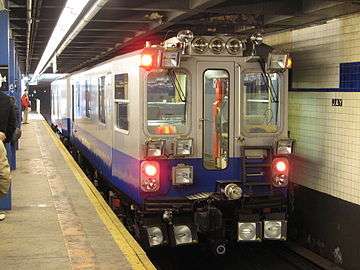New York City Subway rolling stock


The New York City Subway is a large rapid transit system and has a large fleet of rolling stock.
Total fleet
As of November 2016, the New York City Subway has 6418 cars on the roster.[2][lower-alpha 1] The system maintains two separate fleets of cars: one for the IRT routes, the other for the BMT/IND routes. All BMT/IND equipment is about 10 feet (3.05 m) wide and either 60 feet 6 inches (18.44 m) or 75 feet 6 inches (23.01 m) long whereas IRT equipment is approximately 8 feet 9 inches (2.67 m) wide and 51 feet (15.54 m) long. The A Division and B Division trains operate only in their own division; operating in the other division is not allowed because the IRT sections have narrower tunnel segments, tighter curves, and tighter platform clearances than the BMT/IND sections. IRT Division trains would have an unacceptably large gap between the platform and train if they were allowed in the BMT/IND Division, and BMT/IND trains would not fit in the IRT tunnels and stations. The safety train stop (trip cock) mechanism between divisions is also incompatible, being located on opposite sides of the track and train in each division. Service and maintenance trains are composed of IRT sized cars, do not carry passengers, and can operate on either division as the safety train stop is built on both sides of the trucks. However, all rolling stock, in either A or B Division, runs on the same 4 foot 8.5 inches (1,435 mm) gauge.
There is also a special fleet of BMT/IND cars, used for operation in the BMT Eastern Division, which is the J, L, M and Z trains. The BMT Eastern Division has shorter platforms, so these trains can only use eight 60-foot (18.29 m) long cars. As of June 2013, R32 and R42 married pairs along with R143 and R160A four-car sets are assigned to the BMT Eastern Division. 75-foot (22.86 m) long cars, like the R44s, R46s, R68s, and R68As are not permitted on BMT Eastern Division trackage because of sharper curves.
A typical revenue train consists of 8 to 11 cars, although shuttles can be as short as two, and the 7 runs 11-car trains. Train lengths range from about 150 to 600 feet (46 to 183 m) long. As a general rule, trains on A Division lines inherited from the IRT (designated with numbers, plus the 42nd Street Shuttle) are shorter and narrower than those that operate on B Division lines inherited from BMT/IND (designated with letters).
When the Brooklyn Rapid Transit Company entered into agreements to operate some of the new subway lines, they decided to design a new type of car, 10 feet (3.05 m) wide and 67 feet (20.42 m) long. The subject of several patents, the car's larger profile was similar to that of steam railroad coaches, permitting greater passenger capacity, more comfortable seating, and other advantages. The BRT unveiled its design, designated BMT Standard, to the public in 1913 and received such wide acceptance that all future subway lines, whether built for the BRT, the IRT or eventually, the IND, were built to handle the wider cars.
When the R44s and R46s were rebuilt, the rollsigns on the side of the cars were replaced with electronic LCD signs while the front service sign remained as a rollsign. In sharp contrast, the rebuilt R32s and R38s retained rollsigns on the sides, but an LCD display was placed in the front. The MTA has been incorporating newer subway cars into its stock in the past decade. Since 1999, the R142s, R142As, R143s, R160As, and R160Bs have been added into service.[3][4] All cars built since 1992, (including the now out-of-service R110As and R110Bs) are equipped with digital signs on the front, sides, and interior (except for the R110B, which has rollsigns on the front).
Old cars, some from the original companies (IRT and BMT), are preserved at the New York Transit Museum, while others have been sold to private individuals, rail and trolley museums.
Between 1984 and 1989 some of the IRT trains were painted red, giving them the name Redbirds.[lower-alpha 2] By September 2010, many older BMT/IND cars (most R32s, all R38s, all R40s, all R40As, almost all R42s, and almost all R44s) were also retired and replaced with the R160s.
General Overhaul Program
The General Overhaul Program (GOH) was a mid-life overhaul program for neglected subway cars which involved thorough rebuilding of the fleet. Since the completion of the GOH program, the new Scheduled Maintenance System (SMS) program has replaced the GOH program by ensuring that trains do not reach a state in which they would need such an overhaul. The car types which were part of the MTA NYCT GOH program are the IRT Redbirds (R26, R28, R29, R33, R33 WF, R36, R36 WF), as well as IND/BMT cars (R30 GE, R32, R38, R40, R40A, R40M, R42, R44 and R46). These cars were rebuilt between 1985 and 1992. Some cars in various classes from R10 to R46 were also given lighter overhauls during this period.
"R"-prefixed orders
Cars purchased by the City of New York since the inception of the IND and for the other divisions beginning in 1948 are identified by the letter "R" followed by a number; e.g.: R32. This number is the contract number under which the cars were purchased. Cars with nearby contract numbers (e.g.: R1 through R9, or R21 through R36 WF, or R143 through R160B) may be virtually identical, simply being purchased under different contracts.
The New York City Board of Transportation settled on a system of documentation that is still in place under MTA New York City Transit. This included a prefix letter or letters that indicated the Department that the specific documentation, followed by a series of numbers of a length defined by the specific department concerned. For example, the Surface Department used the letter "S", while the Rapid Transit Department used the letter "R". A new R- number is assigned for any vehicle purchase involving a bidding process. Since the 1970s, the system has suffered from "R- inflation" going through only 46 R- numbers in its first 40 years, but over 114 in its subsequent 30. Possible reasons include an increased number of specialized maintenance vehicles that were previously made in house or a lower floor for requiring a formal bidding process in order to reduce waste and abuse.
Disposal at sea

In 2001, the New York City Transit Authority started disposing of retired subway cars by dumping them at sea to create artificial reefs, with the intention of promoting marine life. This option was chosen because it was less expensive than removing asbestos from the cars; the asbestos was determined to not be a hazard in the ocean.[5] Further, the artificial reefs would provide environmental and economic benefits, such as providing shelter for marine animals and creating new fishing opportunities. The first reef constructed was Redbird Reef in Delaware. Eventually, multiple states received retired subway cars for reefs.[6] The program was discontinued in 2010, after more than 2,500 cars were reefed, because newer cars contained more plastic, which was too expensive to economically remove before reefing.[7][8]
Current fleet
| Contract # | Division | Year Built | Builder | Car Length[lower-alpha 3] |
Car Width |
Photo | Fleet numbers (Total ordered) |
CBTC | Assigned Services | Yard assignment |
Notes |
|---|---|---|---|---|---|---|---|---|---|---|---|
| R32/R32A | B | 1964 | Budd Company | 60 ft or 18.29 m | 10 feet (3.05 m) | |
|
No | – 20 cars (2 train; PM rush) – 56 cars (7 trains, AM rush) |
| |
| R42 | B | 1969-1970 | St. Louis Car Company |
60 ft or 18.29 m | 10 feet (3.05 m) | 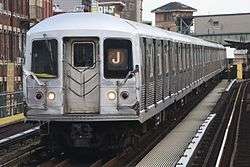 |
4550–4949 (400 total, 50 left in revenue service) |
No | |
| |
| R44 | B | 1971-1973 | St. Louis Car Company |
75 ft or 22.86 m | 10 feet (3.05 m) | |
|
No | Staten Island Railway – 63 cars (15–16 trains) |
|
|
| R46 | B | 1975-1978 | Pullman Company | 75 ft or 22.86 m | 10 feet (3.05 m) |  |
|
No | |
| |
| R62 | A | 1983-1985 | Kawasaki Heavy Industries |
51.04 ft or 15.56 m | 8 feet 9 inches (2.67 m) |  |
1301–1625 (325 total, 315 in service) |
No | |
| |
| R62A | A | 1984-1987 | Bombardier Transportation | 51.04 ft or 15.56 m | 8 feet 9 inches (2.67 m) | _at_125th_St_station%2C_Manhattan.jpg) |
1651–2475 (825 total, 824 in service) |
No | |
| |
| R68 | B | 1986-1988 | Westinghouse Electric Corporation & AMRail |
75 ft or 22.86 m | 10 feet (3.05 m) |  |
2500–2924 (425 total) |
No | – 216 cars (27 trains, PM rush) |
| |
| R68A | B | 1988-1989 | Kawasaki Heavy Industries |
75 ft or 22.86 m | 10 feet (3.05 m) | |
5001–5200 (200 total) |
No | – 136 cars (17 trains, PM rush) |
| |
| R142 | A | 1999-2003 | Bombardier Transportation |
51.04 ft or 15.56 m | 8 feet 9 inches (2.67 m) |  |
1101–1250, 6301–7180 (1030 total) |
No | |
| |
| R142A | A | 1999-2004 | Kawasaki Heavy Industries |
51.04 ft or 15.56 m | 8 feet 9 inches (2.67 m) |  |
7591–7810 (220 total) |
No | –cars (4 trains, PM rush) |
| |
| R143 | B | 2001-2003 | Kawasaki Heavy Industries |
60 ft or 18.29 m | 10 feet (3.05 m) | 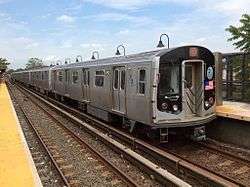 |
8101–8312 (212 total, 208 in service) |
Yes | – 152 cars (21 trains, AM rush) |
| |
| R160A-1 | B | 2005-2010 | Alstom Transportation | 60 ft or 18.29 m | 10 feet (3.05 m) | 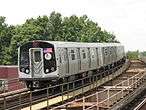 |
8313–8652, 9943–9974 (4-car sets) (372 cars, of 1662 total) |
8313-8380 only | – 16 cars (2 trains, PM rush) – 176 cars (22 trains, PM rush) |
| |
| R160A-2 | B | 2005-2010 | Alstom Transportation | 60 ft or 18.29 m | 10 feet (3.05 m) | |
8653–9942 (5-car sets)[12] (1290 cars, of 1662 total) |
No | |
| |
| R160B | B | 2005-2010 | Kawasaki Heavy Industries |
60 ft or 18.29 m | 10 feet (3.05 m) |  |
No | | |||
| R179 | B | 2016-2018 | Bombardier Transportation |
60 ft or 18.29 m | 10 feet (3.05 m) |  |
3010-3309 (300 cars) |
No | N/A | N/A |
|
| R188 | A | 2011-2015 | Kawasaki Heavy Industries | 51.04 ft or 15.56 m | 8 feet 9 inches (2.67 m) |  |
7211–7590, 7811–7936 (506 total) |
Yes | 363 cars (33 trains) |
|
Track geometry car
The two-car track geometry car set of the New York City Subway helps to measure the system's track geometry. It measures:
- Alignment - "Alignment is the projection of the track geometry of each rail or the track center line onto the horizontal plane," (FRA Definition).[15] Also known as the "straightness" of the tracks.
- Crosslevel - The variation in cant of the track over the length of a predetermined "chord" length (generally 62 feet or 18.90 meters). On straight or tangent track, ideally there should be no variation, while on curves, a cant is generally desired.
- Curvature - The amount by which the rail deviates from being straight or tangent. The geometry car checks the actual curvature (in Degree of curvature) of a curve versus its design curvature.
- Rail gauge - The distance between the rails. Over time, rail may become too wide or too narrow. In North America and most of the world, standard gauge is 4 ft 8 1⁄2 in (1,435 mm).
- Rail profile - Looks for rail wear and deviations from standard profile.
- Warp - The maximum change in crosslevel over a predetermined chord length (generally sixty-two feet).[16]
- Corrugation of running rail surface
- Tunnel and station platform clearances
- Third rail height and gauge
- Vertical gap between third rail and protective board[17]
The track geometry car typically checks each stretch of track about 6 times a year; the car is manually operated, and there are no plans to automate inspection of the track geometry, which is done manually with the help of high-tech equipment aboard the car.[18]
Future fleet
| Contract # | Division | Builder Year To Be Built |
Total | Photo (rendering) |
Notes |
|---|---|---|---|---|---|
| R211 | B | TBA
Late 2010s-Early 2020s |
1025 cars (950 for New York City Subway; 75 for Staten Island Railway)[19] |  |
To replace all remaining R32s, all the remaining R44s (SIR) and possibly all the R46s, and to expand the fleet for the Second Avenue Subway. CBTC-equipped. At least 10 cars to feature open gangways. |
In addition, 168 additional cars are proposed to be built and provided for service on the E, G, L, and N services between 2015 and 2019; the contract number for these growth cars is still unknown, and it is unknown if such cars would be delivered before 2019. However, it is expected that these "new" cars could be cars displaced from other services after the R179s are delivered, as some of the R32s (which were originally planned to be replaced completely by the R179s) will not be replaced until the R211 order is delivered.[20]:35–36
Retired fleet
IRT Pre-Unification listing
| Designation | Year built | Division | Builder | Fleet total | Car numbers | Year retired |
Denotes |
|---|---|---|---|---|---|---|---|
| Composite | 1903–1904 | IRT | Jewett, St. Louis Car, Stephenson, Wason |
500 | 2000–2159, 3000–3339 |
1916 1950 |
2000–2159: Non-powered Trailers only Retired from Subway service in 1916; re-equipped with lightweight trucks and components; and continued in elevated service until 1950. |
| Hi-V "Gibbs" | 1904–1905 | IRT | American Car & Foundry | 300 | 3350–3649 | 1959 | |
| Hi-V "Deck Roof" | 1907–1908 | IRT | American Car & Foundry | 50 | 3650–3699 | 1959 | |
| Hi-V "Hedley" | 1910–1911 | IRT | American Car & Foundry, Standard Steel, Pressed Steel |
325 | ACF: 3700–3809, SS: 3810–3849, PS: 3850–4024 |
1959 | |
| Hi-V "Hedley" | 1915 | IRT | Pullman | 292 | 4223–4514 | 1959 | Non-powered Trailers only; 4223–4250 in their last years were motorized as blind motors with no controls. |
| Lo-V "Flivver" | 1915 | IRT | Pullman | 178 | 4037–4160, 4161–4214 |
1962 | Were built with the original trucks and electrical components removed from the Composites. |
| Lo-V "Steinway" | 1915–1916 | IRT | Pullman | 110 | 4025–4036, 4215–4222, 4555–4576, 4700–4770 |
Equipped with special gearing for the steep grades of the Steinway Tunnels. | |
| Lo-V | 1916–1917 | IRT | Pullman | 695 | 4515–4554, 4577–4699, 4771–4810, 4811–4965, 4966–5302 |
4515–4554 and 4811–4965: Non-powered Trailers only | |
| Lo-V | 1922 | IRT | Pullman | 100 | 5303–5377, 5378–5402 |
Non-powered Trailers only; 5303–5377 equipped with air compressors for brakes | |
| Lo-V | 1924–1925 | IRT | American Car & Foundry | 225 | 5403–5627 | 1964 | |
| Lo-V "Steinway" | 1925 | IRT | American Car & Foundry | 25 | 5628–5652 | Equipped with special gearing for the steep grades of the Steinway Tunnels. | |
| Lo-V "World's Fair" | 1938 | IRT | St. Louis Car | 50 | 5653–5702 | ||
BMT Pre-Unification listing
R-type listing
| Contract # | Year built | Division | Builder | Fleet total |
Car numbers | Year retired | ||
|---|---|---|---|---|---|---|---|---|
| R1 | 1930–1931 | IND | American Car & Foundry | 300 | 100–399 | 1977 | ||
| R4 | 1932–1933 | IND | American Car & Foundry | 500 | 400–899 | 1977 | ||
| R-6-3 | 1935–1936 | IND | American Car & Foundry | 250 | 900–1149 | 1977 | ||
| R-6-2 | 1936 | IND | Pullman | 150 | 1150–1299 | 1977 | ||
| R-6-1 | 1936 | IND | Pressed Steel | 100 | 1300–1399 | 1977 | ||
| R7 | 1937 | IND | American Car & Foundry, | 150 | ACF: 1400–1474, Pullman: 1475–1549 |
1977 | ||
| R7A | 1938 | IND | American Car & Foundry, | 100 | Pullman: 1550–1599, ACF: 1600–1649 |
1977 | ||
| R9 | 1940 | IND, | American Car & Foundry, | 153 | ACF: 1650–1701, PS: 1702–1802 |
1977 | ||
| R10 | 1948–1949 | IND, | American Car & Foundry | 400 | 1803–1852, 3000–3349 |
1989 | ||
| Car number series selected to bracket the Pre-Unification BMT number series 1853–2999. Cars 1803–1852 were renumbered as 2950–2999 in 1970. | ||||||||
| R11 | 1949 | BMT, | Budd | 10 | 8010–8019 | 1977 | ||
| Number series selected to continue from the Pre-unification BMT number series. Test trains, rebuilt into R34 cars in 1965. | ||||||||
| R12 | 1948 | IRT | American Car & Foundry | 100 | 5703–5802 | 1981 | ||
| Car Number series selected to continue from the Pre-unification IRT number series. Rollsigns displayed Post-unification IRT number series, first introduced in 1948. | ||||||||
| R14 | 1949 | IRT | American Car & Foundry | 150 | 5803–5952 | 1984 | ||
| R15 | 1950 | IRT | American Car & Foundry | 100 | 5953–5999, 6200–6252 |
1984 | ||
| R16 | 1955 | BMT, | American Car & Foundry | 200 | 6300–6499 | 1987 | ||
| R17 | 1955–1956 | IRT | St. Louis Car | 400 | 6500–6899 | 1988 | ||
| R21 | 1956 | IRT | St. Louis Car | 250 | 7050–7299 | 1987 | ||
| R22 | 1957 | IRT | St. Louis Car | 450 | 7300–7749 | 1987 | ||
| R26 | 1959–1960 | IRT | American Car & Foundry | 110 | 7750–7859 | 2002 | ||
| Married pairs Even numbered cars have motor-generator and battery, Odd numbered cars have air compressor. | ||||||||
| R27 | 1960–1961 | IND, | St. Louis Car | 230 | 8020–8249 | 1990 | ||
| Married pairs Even numbered cars have motor-generator and battery, Odd numbered cars have air compressor. | ||||||||
| R28 | 1960–1961 | IRT | American Car & Foundry | 100 | 7860–7959 | 2002 | ||
| Married pairs Even numbered cars have motor-generator and battery, Odd numbered cars have air compressor. | ||||||||
| R29 | 1962 | IRT | St. Louis Car | 236 | 8570–8805 | 2002 | ||
| Married pairs Even numbered cars have motor-generator and battery, Odd numbered cars have air compressor. | ||||||||
| R30/A | 1961–1962 | IND, | St. Louis Car | 320 | R30: 8250–8351 R30A: 8352–8411 |
1993 | ||
| Married pairs Even numbered cars have motor-generator and battery, Odd numbered cars have air compressor. | ||||||||
| R33 | 1962–1963 | IRT | St. Louis Car | 500 | 8806–9305 | 2003 | ||
| Married pairs Even numbered cars have motor-generator and battery, Odd numbered cars have air compressor. | ||||||||
| R33 WF | 1963 | IRT | St. Louis Car | 40 | 9306–9345 | 2003 | ||
| single cars, built for IRT Flushing Line some now in work service | ||||||||
| R34 | see R11 | |||||||
| R36 | 1963–1964 | IRT | St. Louis Car | 34 | 9524–9557 | 2003 | ||
| Married pairs Even numbered cars have motor-generator and battery, Odd numbered cars have air compressor. | ||||||||
| R36 WF | 1963–1964 | IRT | St. Louis Car | 390 | 9346–9523, 9558–9769 |
2003 | ||
| Married pairs Even numbered cars have motor-generator and battery, Odd numbered cars have air compressor. | ||||||||
| R38 | 1966–1967 | IND, | St. Louis Car | 200 | 3950–4149 | 2009 | ||
| Married pairs Even numbered cars have motor-generator and battery, Odd numbered cars have air compressor. | ||||||||
| R39 | Never built | IRT, | ||||||
| R40 | 1968– 1969 |
IND, | St. Louis Car Company | 200 | 4150–4349 | 2009 | ||
| Slanted ends, married pairs Even numbered cars have motor generator and battery, Odd numbered cars have air compressor Car numbers were originally 4150–4249, 4350–4449 | ||||||||
| R40A/M | 1968–1969 | IND, | St. Louis Car Company |
200 | 4350–4549 | 2009 | ||
| Married pairs Even numbered cars have motor generator and battery, odd numbered cars have air compressor Car numbers were originally 4250–4349 (modified),[21] 4450–4549 (slant)[22] | ||||||||
| R44 (NYCT cars) | 1971-1973 | IND, | St. Louis Car Company |
288 | 5202-5479 (renumbered from 100-387) | 2010 (NYCT cars) | ||
| 4-car sets (A-B-B-A) formation. A cars have cabs on one end, while B cars have no cabs. Car numbers were originally 100-387. | ||||||||
| R55 | Never built | IND, | The R55 was a proposed car[23] for the B Division (IND/BMT). It was considered in the early 1980s, but never left the drawing board. This order later evolved into the future R68. | |||||
| R110A | 1992 | IRT | Kawasaki | 10 | 8001–8010 | 1999 | ||
| (Built as Contract R130) New Technology demonstrator Cars ending in 1, 5, 6 and 0 have single full-width cabs, and are known as "A" cars. Cars ending in 2, 3, 4, 7, 8 and 9 have no cabs, and are known as "B" cars. All cars are sequentially numbered in A-B-B-B-A configuration as 5-car sets. As of 2014, cars 8001, 8005-8006, and 8010 are stored at 207th Street Yard. Cars 8002-8004 and 8007-8009 were converted into flood pump cleanup cars in 2013. | ||||||||
| R110B | 1992 | IND, | Bombardier | 9 | 3001–3009 | 2000 | ||
| (Built as Contract R131) New Technology demonstrator, 67-foot (20 m) car Cars ending in 1, 3, 4, 6, 7 and 9 have single full-width cabs, and are known as "A" cars. Cars ending in 2, 5 and 8 have no cabs, and are known as "B" cars. All cars are sequentially numbered in A-B-A configuration as 3-car sets. As of 2015, cars 3002–3003, 3007, and 3009 are stored at 207th Street Yard. The other five are used for training at various facilities. | ||||||||
Miscellaneous
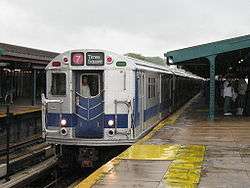
- Air conditioning is standard on all cars R42 and later. R38s 4140-49 and R40s 4350–4549 were also delivered with A/C, and all cars not equipped with A/C from classes R26-R40 (With the exception of the R27, R30, and R33WF) were later retrofitted with A/C. All active cars are equipped with air conditioning and cars with malfunctioning air conditioning are not supposed to be put into service.[24]
- During World War II, a group of old New York elevated line cars dating from the late 19th century was sent west to the San Francisco Bay Area by the United States Maritime Commission for use by the Shipyard Railway, a temporary wartime electric line transporting workers to the Kaiser Shipyards. After the war, most were sold to be used as units in a local motel, but their whereabouts afterwards is unknown. Two of them however were acquired and have been restored by the Western Railway Museum in Rio Vista, California.[25]
- There are many examples of rolling stock built under contract which are not intended for revenue service, such as the R95 money train, R127/R134 garbage train and R156 work locomotive.[26]
- The table below shows what year the TA had expected to retire several car models in 1981.[27]
|
|
Notes
- ↑ See:
- ↑ Redbirds are R26, R27, R28, R29, R30, R33, and R36. All of these cars were replaced by more modern subway trains (R142/R142As) between 2000 and 2003, though many R33 cars are still in use as work trains. Sometimes the term "Redbird" would also be used on the R27 and R30 cars as they were repainted Gunn red during the late 1980s and early 1990s before their retirement in 1993. These were known as the BMT Redbirds.
- ↑ Most IND/BMT (B Division) cars are 60 feet (18.3 m) long unless noted; all IRT (A Division) cars are 51 feet (15.5 m).
- ↑ The New York City Subway R44s were retired in 2010. The Staten Island Railway R44s are still in service.
References
- ↑ more photos at http://www.nycsubway.org/wiki/R-137_Vacuum_Train
- ↑ "New York City Subway Car Fleet Jan 2012 through January 2016". TheJoeKorner. Retrieved February 6, 2016.
- ↑ "R160A in service on N".
- ↑ "R160B in service on N".
- ↑ Kennedy, Randy (August 22, 2001). "End of Line for Subway Cars: The Ocean Floor". New York Times. Retrieved February 6, 2016.
- ↑ Urbina, Ian (April 8, 2008). "Growing Pains for a Deep-Sea Home Built of Subway Cars". New York Times. Retrieved February 6, 2016.
- ↑ Parke, Phoebe (February 26, 2015). "Dumping subway trains into the ocean ... in a good way". CNN. Retrieved February 6, 2016.
- ↑ "For Subway Cars, the Final Trip". New York Times. May 15, 2011. Retrieved February 6, 2016.
- ↑ "R32 3422 awaiting final disposal at 207th Street Yard" Retrieved on 2008-04-16
- ↑ "R32 3573 awaiting final disposal at 207th Street Yard" Retrieved on 2008-04-16
- 1 2 http://i42.tinypic.com/r2oqb8.jpg
- ↑ "R160A & R160B Car Numbers" Retrieved on 2008-05-04
- ↑ Page 32 (Footnotes)
- ↑ "MTA - news - New Subway Cars Being Put to the Test". mta.info.
- ↑ Track Safety Standards Compliance Manual. Federal Railroad Administration, 2009. Print, Web. Track Safety Standards Compliance Manual
- ↑ Uzarski, Dr. Don. CEE 409 - Railroad Track Engineering, Class Notes. University of Illinois at Urbana-Champaign, 2009. Print.
- ↑ "MTA News". mta.info.
- ↑ Adam Clark Estes. "This Superheroic Train Keeps New York City's Subway Safe". Gizmodo. Gawker Media.
- ↑ "MTA Capital Program Oversight Committee Meeting: January 2016" (PDF). mta.info. Metropolitan Transportation Authority. January 2016. Retrieved January 23, 2016.
- ↑ "MTA Twenty-Year Capital Needs Assessment 2015-2034" (PDF). Metropolitan Transportation Authority. October 2013. Retrieved 11 August 2015.
- ↑ "Showing Image 5292". nycsubway.org.
- ↑ "Showing Image 12845". nycsubway.org.
- ↑ "Roster Summary By Type". Retrieved 2009-08-25.
- ↑ Jaffe, Eric (Aug 15, 2012). "A Brief History of Air-Conditioning on the New York Subway". The Atlantic Cities. Retrieved August 15, 2012.
- ↑ "Richmond Shipyard Railway 1943–1945" Retrieved on 2008-04-16 Archived July 21, 2006, at the Wayback Machine.
- ↑ "www.nycsubway.org". www.nycsubway.org.
- ↑ "www.nycsubway.org". www.nycsubway.org.
Further reading
- Cudahy, Brian J. Under the Sidewalks of New York: The Story of the Greatest Subway System in the World, 2nd Revised Edition. Fordham University Press, New York, 1995. ISBN 0-8232-1618-7
- Davis, Ed Sr. (1985). They Moved the Millions: A Brief History of Passenger Cars of America's Most Heavily Travelled Passenger Railway, the New York City Transit System. Livingston Enterprise.
- Dougherty, Peter J. Tracks of the New York City Subway, version 4.2. 2007
- Kramer, Frederick A. Building the Independent Subway. Quadrant Press, Inc.; New York, 1990. ISBN 0-915276-50-X
- Sansone, Gene. Evolution of New York City subways: An illustrated history of New York City's transit cars, 1867–1997. New York Transit Museum Press, New York, 1997. ISBN 978-0-9637492-8-4.
External links
| Wikimedia Commons has media related to New York City Subway trains. |
- nycsubway.org New York City Subway Cars
- Pre-Unification Cars (BMT)
- Pre-Unification Cars (IRT)
- R-Type Cars 1932 to 1987
- R-Type Cars 1999 to Present (NTT)
- 'R' Type Roster (includes non-train contracts)
- Forgotten NY Subway Link
- IRT Car Assignments – November 6, 2016
- BMT-IND Car Assignments – November 6, 2016
- New York City Subway Car Fleet June 2010 through November 2016

